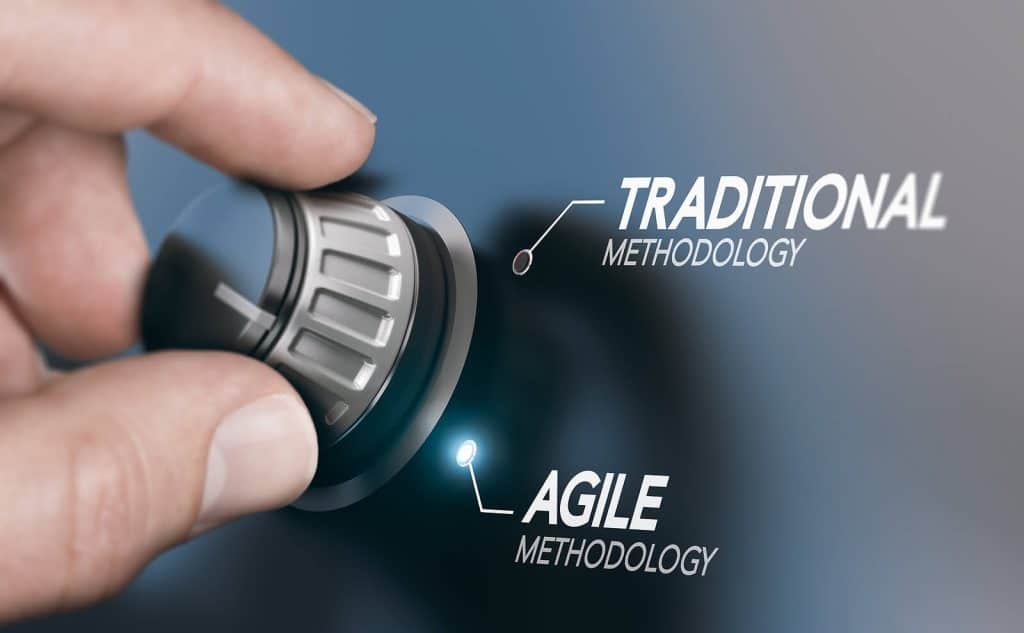Introduction
The debate between agile project management vs traditional project management methodologies continues to spark discussions among project managers and teams across the IT sector and beyond.
Table of Contents
ToggleWhether you’re a seasoned project manager or new to project management, this article will help you understand more about these different project management approaches. It will also help you decide if a traditional project management methodology or an agile methodology is more appropriate for how you manage projects.
I will explore the differences and similarities between managing projects with traditional methods and using agile project management methods so you can make an informed choice.
Understanding Project Management
Project management is an essential discipline in the business world, offering structured methods and tools to lead projects from inception to completion. It encompasses planning, executing, monitoring, controlling, and completing work within set constraints.
As the use of project management expands across different sectors, choosing what to use — an agile methodology, traditional project management, or a hybrid—can make or break the success of a project.

Agile Project Management Methodology: Embracing Flexibility and Collaboration
Agile project management came out of agile software development which itself came from the principles of the Agile Manifesto.
To deliver working software, the Agile Manifesto prioritizes individuals and interactions, working solutions, customer collaboration, and responding to change.

The core of agile project management lies in its iterative approach using short timescales between each delivery. The entire project is delivered in short increments, each taking into account customer feedback. This facilitates continuous adjustment to evolving project needs, making it particularly advantageous in environments marked by uncertainty and rapid change.
Key Features of Agile Project Management
Iterative Development: Agile project management divides projects into small, manageable iterations or sprints, enabling frequent reassessment and adaptation of plans based on current needs.
Customer Collaboration: The team maintains a close partnership with customers, incorporating customer feedback, ensuring the project aligns with client expectations and evolving requirements throughout the project timeline.
Adaptive Planning: While there is an overarching direction, detailed planning is flexible and adjusts to the project’s schedule and lessons learned from each iteration.
Cross-functional Teams: Agile teams are self-organizing and multidisciplinary, pooling a variety of skills to tackle tasks more dynamically and efficiently.
Emphasis on Deliverables: The agile project methodology focuses on the rapid delivery of value through functional prototypes or product increments, ensuring tangible progress and the ability to pivot as necessary.
Continuous Improvement: Regular retrospectives are always conducted, allowing teams to reflect on performance and identify areas for enhancement through the whole project.
Transparency and Communication: Agile management fosters open communication and transparency within each team member and with stakeholders, promoting accountability and clarity.

Agile frameworks like Scrum, Kanban, Six Sigma and Lean offer techniques and concepts that embody these principles, each with unique practices and tools designed to cater to different project requirements and agile team preferences. Here’s an example from the Project Management Institute that shows how Agile Scrum works.
These methodologies excel in creating a collaborative environment where project teams are empowered to make decisions and adapt to changes swiftly, ensuring not just customer satisfaction but also enhancing team morale and project outcomes.
Agile methods are ideally suited for projects with a high degree of uncertainty, where requirements are expected to evolve, or where delivering small sections of the project in a short timeframe is critical.
By valuing adaptability and direct communication, agile project management ensures that projects remain aligned with client needs and market trends throughout the life cycle, ultimately leading to more successful and relevant outcomes.
Traditional Project Management: A Structured Approach
A traditional methodology for managing projects is characterized by its methodical, phase-based strategy, where each segment of the project must be completed in sequence before moving on to the next.

The traditional project management approaches are ideal for projects with well-defined objectives and fixed requirements. Hence a traditional project management methodology is ideal for a project management team who want predictability, a predefined process, and firm control over the project’s trajectory.
Characteristics of Traditional Project Management
Sequential Phases: Projects are divided into distinct phases such as initiation, planning, execution, monitoring, and closure, with the start of each phase dependent on the completion of the previous one.
Upfront Planning: The traditional system focuses on extensive planning at the outset. Every aspect of the project, from scope to resources and timelines, is defined early on.
Comprehensive Documentation: Detailed documentation is a necessity, ensuring every requirement, plan, timescale, resource, and change is thoroughly defined and recorded.
Detailed Plan with Clear Milestones and Deliverables: Each phase has specific milestones and deliverables, which must be delivered before progressing to the next phase.
Defined Roles and Responsibilities: The project team operates within a hierarchical structure, with clear roles, responsibilities, and reporting lines.
Change Management: Changes are managed through formal procedures. Modifications to the project scope or objectives typically require approval through a structured process.
Risk Management: Risks are identified, analyzed, and mitigated during the early stages and beyond, with strategies developed to manage potential impacts on the project.
Quality Control: Emphasizes the adherence to predefined standards and specifications, with regular quality assurance checkpoints.

Traditional project management is particularly effective for projects where stability and minimal deviation from the plan are critical.
Its structured nature provides a clear, predictable path to project completion, making it an ideal choice for industries and projects where changes are minimal or costly.
By adhering to a predefined sequence of steps and placing a strong emphasis on documentation and planning, this methodology aims to ensure that projects are completed on time, within budget, and to the specified quality standards. However, the rigidity often leads to budget and timeline issues.
Key Differences Between Agile and Traditional Project Management

Agile and traditional project management methodologies offer distinct philosophies, organizational structures, processes, and outcomes.
Agile project management is noted for its flexibility and responsiveness, prioritizing rapid iterations, customer feedback, and adaptive planning.
A traditional project management methodology is noted for rigidity and resistance to change, emphasizing upfront planning, comprehensive documentation, and a linear progression through sequential stages, offering predictability and control over the project’s scope and deliverables.
The table below outlines the fundamental contrasts between these two methodologies:
| Feature | Agile Project Management | Traditional Project Management |
| Approach | Iterative and incremental, allowing for changes and adaptations throughout the project. | Sequential and linear, with a defined sequence of phases that do not overlap. |
| Flexibility | High, with the ability to adapt to changes rapidly. | Low, with changes being difficult and costly once the project is underway. |
| Customer Involvement | Continuous, with frequent feedback loops and adjustments based on customer input. | Typically limited to the early and final stages of the project, with less ongoing involvement. |
| Planning | Upfront planning is minimal; the focus is on adapting as the project evolves. | Extensive upfront planning, with detailed documentation and a fixed schedule. |
| Project Management Role | Facilitative, with the project manager acting as a coach or servant-leader. | Directive, with the project manager having clear authority and control over project decisions. |
| Delivery | Incremental, with working parts of the project delivered throughout the project timeline. | In the end, with a single delivery upon completion of the entire project. |
| Documentation | Lightweight and just sufficient to meet the current needs. | Comprehensive, often detailed in the planning phase and maintained throughout. |
| Risk Management | Built into the process, with risks being identified and addressed continuously. | Managed upfront, with risks identified and mitigation plans developed early. |
| Best suited for | Projects in dynamic environments with uncertain or evolving requirements, where stakeholder engagement and adaptability are paramount. | Projects that have well-defined scope requirements, and deliverables, where a clear, unchanging roadmap is essential to success. |
Understanding these differences is crucial when choosing the best project management methodology for a particular project.
Selecting between Agile and Traditional project management depends on the project’s specific needs, the team’s dynamics, and the stakeholders’ expectations.
By carefully considering these factors, project managers can ensure the methodology chosen aligns with the project’s goals, thereby maximizing efficiency, effectiveness, and stakeholder satisfaction.
Bridging Agile and Traditional Project Management: Shared Objectives and Principles
Despite the apparent differences between agile and traditional project management methodologies, they share several foundational principles and goals that bridge the gap between flexibility and structure.
Understanding these commonalities can help organizations and project managers leverage the strengths of both approaches, fostering a more inclusive and adaptable project management strategy.
Project Success Focus
Both methodologies strive for the successful delivery of projects, ensuring they meet or exceed stakeholder expectations in terms of value, quality, and satisfaction.

Defined Roles and Responsibilities
Whether following an agile approach with roles such as Scrum Master and Product Owner, or a traditional approach with a Project Manager and Project Board, both methodologies recognize the importance of clear roles and responsibilities to ensure project accountability and clarity.
Importance of Customer/Stakeholder Satisfaction
Agile methodologies emphasize working with customers and getting feedback, while traditional methodologies seek to meet predefined customer requirements. Both aim to achieve customer satisfaction as a critical project success metric.

Risk Management
Both approaches incorporate risk management strategies to identify, assess, and mitigate risks throughout the project lifecycle, ensuring proactive measures are in place to address potential issues before they impact the project.

Quality Assurance
Quality is a key concern for both agile project management and traditional project management. Agile methodologies integrate quality checks at the end of each short iteration, whereas traditional methodologies employ quality assurance processes at specific project milestones.
Adherence to Budget and Schedule
Both methodologies aim to deliver projects within the agreed-upon budget and schedule. Agile manages this through iterative planning and scope adjustment, while traditional project management relies on detailed upfront planning to ensure project timelines and budgets are adhered to.
Communication and Documentation
Effective communication is crucial in both methodologies, though the forms and frequency may differ.
Agile favors more frequent and informal communication channels, while traditional project management often relies on formal documentation and structured communication methods. Nevertheless, both understand that keeping stakeholders informed and engaged is key to project success.
Continuous Improvement
Agile methodologies explicitly include retrospectives where the team discusses progress and reflect on how well work is progressing against expectations. Traditional project management also values lessons learned, but typically only at the end of the project, applying insights from past projects to new ones.

Recognizing these similarities highlights that agile and traditional project management are not mutually exclusive, but can be complementary strategies which are tailored to fit the unique needs of a project.
By focusing on the shared objectives and principles, project managers could choose the most appropriate elements from each methodology to create a hybrid approach that combines the best of both worlds, ensuring projects are managed effectively, efficiently, and adaptively.
Advantages and Disadvantages of Agile and Traditional Approaches
Agile Project Management
Advantages
Flexibility and Adaptability: Agile’s iterative process allows for easy incorporation of changes.
Customer Collaboration: Emphasizes ongoing customer input for better end results.
Faster Deliveries: Agile’s sprints enable quicker releases of project segments.
Disadvantages
Not Suitable for Large Fixed Deliverable Projects: Agile can struggle to deliver large fixed timescale and scope projects, such as building roads and large buildings.
Requires High Customer Involvement: The success of agile projects hinges on the customer’s willing involvement and feedback.
Risk of Scope Creep: Without careful management, the project’s scope can expand uncontrollably due to its flexible nature.
Traditional Project Management
Advantages
Clear Structure and Predictability: Offers a straightforward, well-documented path from project start to finish.
Defined Roles and Responsibilities: Everyone on the project team knows their role within a hierarchical structure.
Efficient for Large, Complex Projects: Well-suited to handling projects where scope, time, and cost are fixed.
Disadvantages
Inflexibility: Changes are hard to implement once the project has begun.
Less Customer Involvement: The customer’s input is typically limited to the planning phase, which can result in a final product that doesn’t meet their needs.
Risk of Delivering Outdated Solutions: Due to the lengthy nature of these projects, there’s a chance the product may be outdated by the time it’s delivered.
When to Choose Agile Over Traditional Project Management
Think about agile project management when your project is expected to experience frequent changes in scope, when the full requirements are unknown, when innovation and speed are critical, or when the project benefits from regular stakeholder feedback.
Agile is particularly effective in dynamic environments where end-user needs are likely to evolve, such as in software development projects.
When Traditional Project Management Is the Better Choice
Traditional project management methodologies can shine in scenarios where there is a clear vision of the product from the outset, and changes are minimal.
Large-scale construction projects, manufacturing, and other industries where detailed upfront planning and regulatory compliance are crucial, benefit most from this approach.
Conclusion
The debate between Agile vs traditional project management does not yield a one-size-fits-all answer. Each methodology has its strengths and weaknesses, and is suited to different project types and environments.
The decision should be based on the project’s specific needs, team dynamics, and the end goals. By weighing the advantages and disadvantages of each approach, a project manager can select the most effective methodology to ensure project success and stakeholder satisfaction.
FAQs
Q: Can Agile and Traditional Methodologies Be Combined?
A: Yes, a hybrid approach, often called “Agile-Waterfall Hybrid,” combines both methodologies’ strengths to suit projects that benefit from both planning and flexibility.
Q: Is an Agile Methodology More Expensive Than Traditional Project Management?
A: Not necessarily. While agile project management may require more frequent reassessment, its flexibility can lead to cost savings by avoiding late-stage changes that are more expensive to implement in traditional projects.
Q: How Do I Know If an Agile Methodology Is Right for My Project?
A: Consider managing your project in an agile way if it involves complex and/or uncertain requirements, or if it’s in a domain where rapid innovation is critical. Agile project management is ideal when stakeholder feedback is vital throughout the project.





